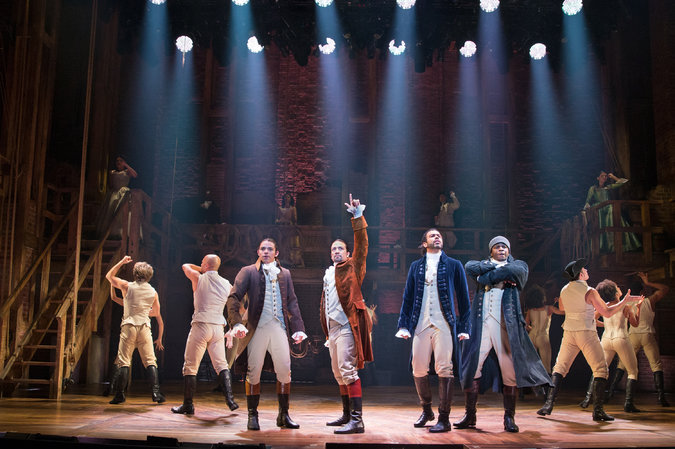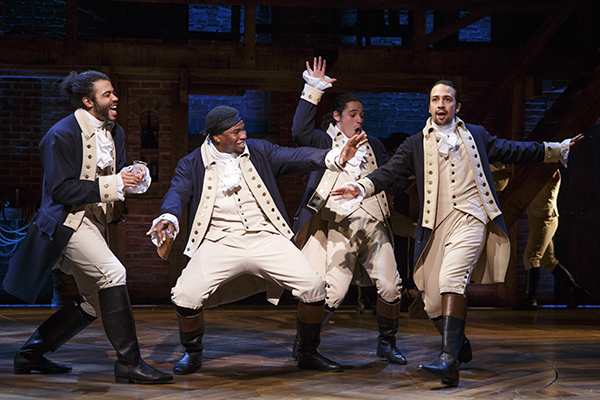A Reading List Inspired By the Musical Hamilton
What do you do when you need to take your Hamilton musical obsession one step further, even beyond reading the 832-page biography that inspired the musical? Read what the Hamilton characters are reading, of course.
The History of the Kings of Britain by Geoffrey of Monmouth
In “Aaron Burr, Sir,” Lafayette introduces himself as “The Lancelot of the revolutionary set,” letting us all know that he read The History of the Kings of Britain. Lancelot is often portrayed as King Arthur’s greatest champion and the most skilled swordsman and jouster of his day. This reference comes back in “My Shot” when Hamilton refers to his new friend as “Mister Lafayette, hard rock like Lancelot.” Lafayette!

Common Sense by Thomas Paine
Angelica Schuyler shows off her literary prowess from her first moments on stage. “I’ve been reading Common Sense by Thomas Paine,” she proclaims – almost as a challenge to the others on stage with her. Paine’s pamphlet explained the immediate need for independence from British rule and was an instant bestseller. George Washington even had Common Sense read to all his troops while they were surrounding the British army in Boston.
The Declaration of Independence by Thomas Jefferson
A breath later, Angelica gives her take on Thomas Jefferson’s seminal work.
'We hold these truths to be self-evident
That all men are created equal.'
And when I meet Thomas Jefferson
I’m’a compel him to include women in the sequel.”
Angelica did go on to meet Thomas Jefferson, though there’s no telling if she discussed the androcentric nature of the Declaration. The Schuyler sisters are clearly confident, educated feminists and their reading material reflects that. If it had been written in her lifetime, Angelica would have loved reading The Declaration of Sentiments that came out of the Seneca Falls Conference in 1848. Work!

Macbeth by William Shakespeare
In “Take A Break,” Hamilton demonstrates his love for Shakespeare with the line
My dearest, Angelica
Tomorrow and tomorrow and tomorrow
Creeps in this petty pace from day to day.
(Note the comma after “dearest.”) Hamilton was the son of a Scotsman and he cleverly spends the bulk of this letter to Angelica referring to both his own story and Macbeth as Scottish tragedies. He shares a fatal flaw with The Scottish Play’s title character: ambition. Later in the song, Angelica sings “Screw your courage to the sticking place,” referencing Macbeth to his face. Should have gone on vacation upstate when you had the chance, Hamilton.

Hebrew Scriptures and The Bible
In “One Last Time,” President George Washington quotes scripture to persuade Hamilton to draft his Farewell Address.
'Everyone shall sit under their own vine and fig tree
And no one shall make them afraid'
They’ll be safe in the nation we’ve made.
While the vine and fig tree motif shows up in scripture several times, this lyric is quoting Micah 4:4. George Washington used this phrase in his correspondence nearly fifty times over the course of his life.

Metamorphoses by Ovid
After the Reynolds Pamphlet is published, Angelica and Eliza Schuyler turn to Greek mythology to describe Hamilton’s actions. In “Burn,” Eliza sings
Do you know what Angelica said
When she read what you’d done?
She said 'You’ve married an Icarus
He has flown too close to the sun.'
In the myth, Icarus ignores his father’s warning ends up melting his wax wings and falling into the sea. It’s a warning against hubris and the perils of personal over-ambition.
The West Indian: A Comedy by Richard Cumberland
When Philip Hamilton is on his way to challenge George Eacker in “Blow Us All Away,” a passerby says that she
saw him just up Broadway a couple of blocks
He was going to see a play.
That play was The West Indian: a comedy. Richard Cumberland’s play was a success in London, where it ran at the Drury Lane Theatre in 1771. The play later went on to be produced in the West Indies and the United States.




